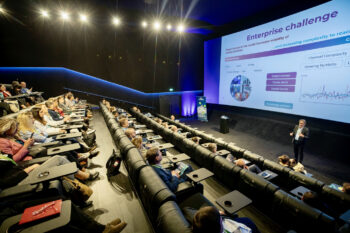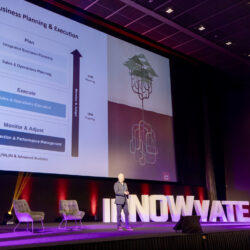Supply chain technology is thriving, but is not the answer to everything

The rise of artificial intelligence (AI) has provided a huge boost to supply chain planning solutions. At Supply Chain Media’s annual inNOWvate Supply Chain Event, vendors showcased the latest developments, but also warned against setting expectations too high. “It’s not about the technology itself, but rather how much value it adds.”
By Harm Beerens
Almost all speakers during the inNOWvate planning track began their presentations by referring to the familiar challenges: disruptions, resource shortages, inflation, sustainability, lack of human resources. They then explained how their software-based or concept-based solution could help to address these challenges.
One of the many highlights was the presentation by Sandeep Walia of Slimstock. “The technological tools available to companies to help optimize their supply chains are amazing,” he said. “When you think how far we have advanced in robotics, artificial intelligence, Internet of Things, predictive analytics and all the other terrific technology, this should be the absolute moment of glory for us as supply chain people.”
Yet the reality is very different, he claimed. Virtually all companies are experiencing problems and considerable supply chain uncertainty, and the reason is that supply chains have become so complex that technology alone is no longer enough. One solution that companies are still underutilizing, according to him, is collaborative supply chain planning. “Individual departments still work far too much in isolation, partly because they are pursuing different goals. Introducing a common set of KPIs can significantly improve this.”
ChatGTP
Another presentation that demonstrated how technology can provide a broader-based approach to supply chain planning was held by Piet Buyck, CEO of Garvis. This scale-up, which was founded in 2020, has always made use of some AI, but recently added ChatGTP into the mix. This popular chatbot enables users to ask questions – and receive answers – about the demand planning process in plain, easy-to-understand language.
Buyck showed an example by typing in the following command: “Show the evolution of demand for my three main customers.” The ChatGTP system thought for a few seconds before displaying three neat bar graphs showing each customer’s increase in demand, including the reasons for the increase such as a promotional campaign, seasonal pattern or trend. Buyck: “Supply chain data that was previously only accessible to specialists becomes accessible to other departments thanks to ChatGTP.”
Pricing
Supply chain planning systems have traditionally focused on operational issues, such as which mix of products should be produced, which volumes of materials to purchase and how much inventory to keep. Such decisions are made based on the expected demand and algorithms that make trade-offs between the desired service level, costs and various technical constraints, for example.
The sales price is a crucial factor that has often been forgotten up until now, according to Antoine Brouwer of IG&H. “How can you make a forecast if you don’t explicitly include the price? Traditional forecasting systems look at historical sales data and extrapolate that into the future. But what if your competitor suddenly switches to a much lower price? This will have a major impact. In our retail solution, the sales price is actually an integral part of the planning process.”
Better forecasting accuracy
 The use of artificial intelligence improves the forecasting accuracy and makes it easier to achieve supply chain goals, said Sami Salminen of Chainalytics. He gave examples of how AI can be utilized for demand planning, for promotion planning and in a production environment also for maintenance planning. Like IG&H, he emphasized the power of pricing and showed how varying the price can generate optimal value from inventory.
The use of artificial intelligence improves the forecasting accuracy and makes it easier to achieve supply chain goals, said Sami Salminen of Chainalytics. He gave examples of how AI can be utilized for demand planning, for promotion planning and in a production environment also for maintenance planning. Like IG&H, he emphasized the power of pricing and showed how varying the price can generate optimal value from inventory.
“Determining the best price is a complex process; you have to look at your cost price and at what your competitors are asking for a product, but it also depends on your market strategy. If you are a newcomer, you may want to temporarily offer the lowest price to capture market share. By applying machine learning, you can quickly and automatically determine the right prices for your products, even if you have a large product range,” Salminen commented.
Command centres
In addition to highlighting some interesting applications of AI, the inNOWvate planning track also introduced new supply chain planning concepts such as ‘command centres’. “These are actually the next generation of control towers,” stated Glen Campbell from Oracle. “Control towers have been around for some time, but they focus primarily on visibility, i.e. detecting issues. Command centre technology adds to that by allowing you to actually solve the issues. That’s what we call ‘resilience’.”
Campbell explained that a command centre contains predefined use cases and the best way to deal with all kinds of issues. It also enables users to run simulations of decisions before executing them. Another feature is that the system learns from its decisions, resulting in continuous self-improvement.
Antifragile
Ludovic Lezenven (pictured) of software vendor QAD used the term ‘antifragile’. He explained that the term comes from author Nassim Nicholas Taleb’s book of the same name, and represents ultimate resilience. “Companies that have designed their supply chain to be as efficient and lean as possible leave themselves exposed to disruptions. They are ‘fragile’. Supply chains that are resilient can adapt and survive in an uncertain and ever-changing environment,” Lezenven said.
“Antifragile means that you don’t just survive, but actually flourish in the face of uncertainty. You are able to assess the consequences of disruptions very quickly, identify which part of your supply chain will be impacted and take immediate action.” During his presentation, he discussed what it takes to become antifragile, including being able to properly distinguish between the cause and effect of disruptions, thinking cross-functionally and working in small teams. He also showed how QAD’s supply chain solutions support this.
The language of money
Last but not least, John Rothmann of Blue Ridge took a completely different tack, advising supply chain professionals not to become bogged down in detailed concepts and complex software functionalities. “If you want to get approval to invest in supply chain planning software, don’t start talking to your boss about functionality. Talk the language of money instead, because that’s what the management team understands best.”
He presented an example of a Blue Ridge client that had been weathering a storm, but managed to increase profitability by 180% within one year of deploying smart supply chain software. Rothmann: “Of course, it won’t be so easy to do that at every company, but my message is that it’s all about the business case. What does it actually achieve in practice? It’s not about the technology itself, but rather how much value it can add. That’s what really matters. Everything else is a bonus.”










